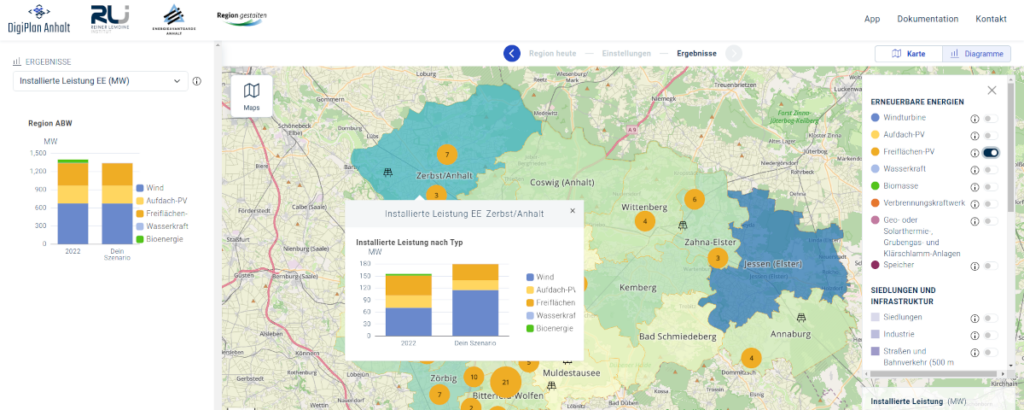Digital Planning Atlas Anhalt – DigiPlan

Project description
Climate protection must also be strengthened in rural regions. This can be achieved through efficient and transparent control, for example through decentralized energy systems. The Energieavantgarde Anhalt e.V. (EAA) is working towards this goal in the project “Digital Planning Atlas Anhalt” – DigiPlan Energiewandel Anhalt (Dessau-Roßlau). The RLI supports the implementation of the project. The scientists of the research unit Transformation of Energy Systems will renew the stakeholder empowerment tool “Regional Energy Balance Circle” for the region Anhalt-Bitterfeld-Wittenberg (StEmp-Tool ABW). They will update the data basis, add a carbon footprint to it and revise the user interface. StEmp tools are simulation-based, digital instruments that help people in participation processes to make decisions and their consequences more transparent and to understand them better.
Making the effects of measures visible and understanding them better
With the StEmp tool, users can see, for example, how many people live in the communities, how much electricity comes from renewable energies, or how many wind energy plants there are. In addition to the status quo, the effects of various climate protection measures can also be made visible. For example, users can select a scenario for the expansion of wind energy plants or vary the proportion of photovoltaic and biomass plants or conventional power plants. This makes the effects of certain decisions and climate protection measures in the region visible and easier to understand.
Strengthening climate protection regionally and enabling participation
The EAA is carrying out the project “Digital Planning Atlas Anhalt” as part of the funding program Region Gestalten. An important aspect of this is the participation of citizens. However, the complexity of energy systems and related issues often complicates the participation process. Interested stakeholders should get a better understanding of different scenarios of the regional energy system with the help of the StEmp tool. The overall project also aims to achieve goals such as the digitization and automation of energy systems through data management and the transferability of the open source application to adjacent areas.
More actuality and new CO2 balance
The StEmp tool contains extensive geo-information data such as political borders, infrastructure data, soft and hard taboo zones, and energy data. RLI will update all existing data and information to 2021. The current baseline is from 2017, and only open licensed datasets will be used as data sources. The StEmp tool will also be expanded to include a carbon footprint for the energy sector. The emissions are presented in aggregated form. If users change the energy mix, the emissions will also change. The results are displayed in maps, tables or diagrams.
Project period: March 2022 – October 2023
Tasks
- Data update, e.g., energy supply, demand, RE potential areas.
- Integration of information on GHG emissions
- Revision of the user interface
- Conducting workshops with regional stakeholders in the Anhalt-Bitterfeld-Wittenberg region


